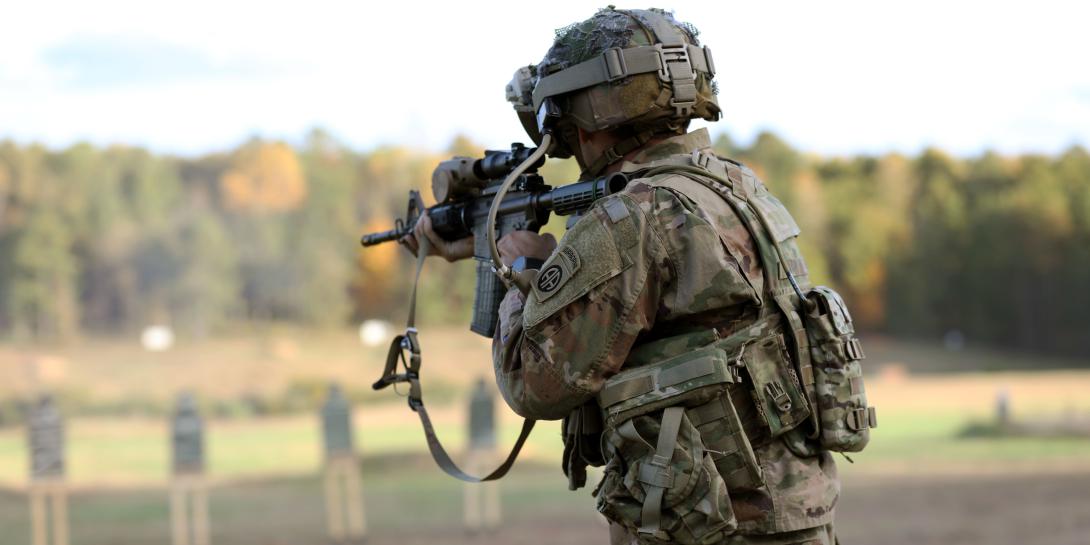Army Recharges Conformal Wearable Battery Design
During the U.S. Army’s Project Convergence 2021 experiment scheduled for October, researchers will assess silicon anode cells for its Conformal Wearable Battery to be used with the Integrated Visual Augmentation System (IVAS) and the Nett Warrior system. The batteries double the power, allowing those systems to run much longer without increasing size and weight. Ultimately, the new cells could be used in a wide range of batteries for the military and commercial sectors, including those used to power tactical radios, electric cars and cellphones.
The Army first fielded the current Conformal Wearable Battery (CWB), which is made by Inventus Power, more than a decade ago. It is a wearable battery that conforms to the shape of individual soldiers so that it doesn’t get in the way as the more traditional, brick-type batteries often did. The current CWB is a rechargeable lithium-ion battery. The new versions also are a kind of lithium-ion, but the internal cells use a silicon anode for greater power.
The Army’s Command, Control, Communications, Computer, Cyber, Intelligence, Surveillance and Reconnaissance (C5ISR) Center is working to improve manufacturing of silicon anode cells to lower cost and potentially add more energy into the batteries. The focus during Project Convergence 2021 will be on demonstrating two versions of a silicon anode CWB that improve power performance and have equivalent or better safety when compared to the current CWB. Lessons learned from this year’s Project Convergence will allow researchers to improve the batteries for Project Convergence 2022.
As the Army develops and fields more soldier-worn electronics, power demands are continuing to increase. In recent years Army leaders realized the importance and potential drastic leap in capability that silicon anode technology can bring to soldier-worn batteries and have invested in speeding up technological development, allowing researchers to accomplish in less than two years what they initially expected to accomplish in three.
C5ISR Center researchers are currently working with two companies—which they will not yet identify—on the new batteries. One company demonstrated its product last year during an event known as the IVAS Soldier Touchpoint 3. “That was a good chance to bring a subset of prototype CWBs and outfit some soldiers with it to get some more feedback. It was pretty successful. We got twice the energy, twice the run time of the system,” says Ethan Wise, an electronic engineer with the C5ISR Center. “We’ll hopefully get the same outcome at Project Convergence 21 and beyond but with some additional improvements in safety and packaging and manufacturing.”
Although the current CWB has never had a safety problem, researchers stress the importance of continuing that streak of success. “Changing the chemistry, you sometimes introduce a little bit of risk, and we’re targeting that risk to reduce it,” says David Shoemaker, a chemical engineer and a contract manager with the C5ISR Center. “As you increase the energy of any sort of chemistry … there’s always that risk that if someone steps on it, or if it gets penetrated, that it could catch fire.”
Wise describes lithium-ion as the “last big revolution” in battery technology, but he notes that silicon anode cells are gaining attention in the commercial world. Commercial interest is important because companies can attract research and development funding from sources other than the military and because it drives down the costs. “If you look at the Tesla battery day, they mention silicon in their anodes more than once. That’s part of how they’re getting more energy into their cells,” Wise offers.
Additionally, the Army has been engaged in a manufacturing-technology effort with one of the unnamed vendors to help improve manufacturing efficiency. “The man-tech effort will significantly bring down the price and increase production rate, but the company is also looking at getting other investors because ultimately they would like to target the commercial industry for electric vehicles and cellphone batteries,” Shoemaker reports. “Silicon anode can fill that gap where more people would like electric vehicles to go farther and last longer… without radically changing how the batteries are made.”
Silicon anode cells also could be used for a wide variety of batteries in the military and other government departments or agencies, including law enforcement agencies. “The tactical radio battery uses a cylindrical-type cell, which many people use in laptop batteries and hoverboards, and we would be able to showcase later what a silicon anode could do to improve those form factors as well,” Shoemaker suggests. “This is a multi-use application as well for this new chemistry.”
Individual program managers will determine which versions of the CWB to purchase but having multiple vendors capable of meeting the requirements offers benefits. “We, the Army, are not huge fans of being limited to one supplier of something because it’s a huge risk on our part. Ultimately, we would like to have multiple vendors utilizing this technology, but we’ll see where we are a few years from now,” Wise says.





Comments